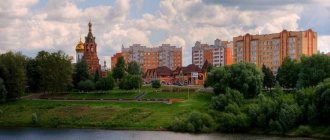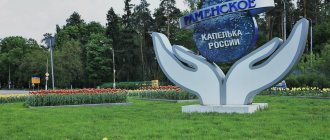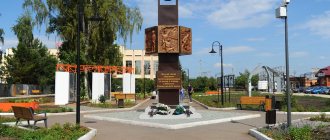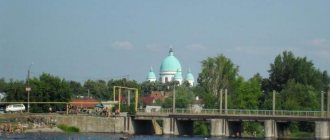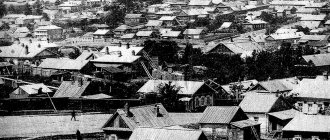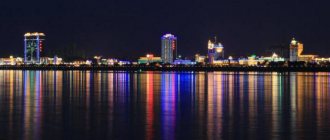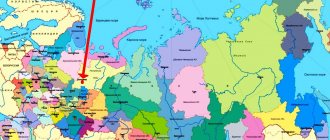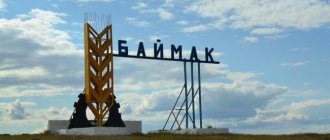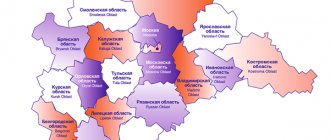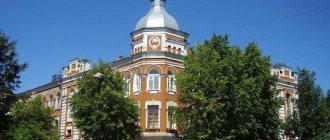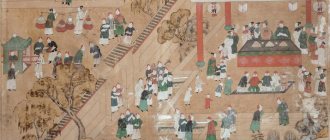The city of Ramenskoye is located in the second zone of cities near Moscow. This is precisely what its disadvantages and advantages are associated with. Good infrastructure, low level of environmental pollution, comfortable urban space and... quite a long road to Moscow.
The city of Ramenskoye is the administrative center of the district of the same name in the southeast of Moscow. It is located at a sufficient distance from the Moscow Ring Road (30 km along the Ryazanskoye or Yegoryevskoye highway). According to 2015 data, the city's population is more than 106 thousand people.
Ramenskoye city on the map
The nearest cities are Zhukovsky, Bronnitsy and Elektrougli.
Is Ramenskoye really one of the most environmentally friendly cities in the Moscow region?
Located at a decent distance from the Moscow Ring Road from the north and east, the city of Ramenskoye is surrounded by pine forests, in some places there are birch groves, and in the southwest the Moscow River stretches along the city. Flowing from the capital, it can no longer boast of cleanliness, but fortunately, there are other bodies of water in the surrounding area.
Central city park near the registry office
It’s noticeably easier to breathe in Ramenskoye, the air is clean not only thanks to the forests, but also due to the low number of anthropogenic pollutants. It’s no wonder that there are many sanatoriums in the area for people with lung diseases. One of the nearest rest houses “Lesnoy Gorodok” is located on the banks of the Doninka River.
So the second pleasant feature of the city is the absence of heavy hazardous industries. Although there was once a textile factory in its center a hundred years ago, now there are only a dozen small enterprises here. On its territory there are mechanical and instrument-making factories that produce bread, and nearby there are meat and dairy factories.
The work of the Vim Bill Dan Drinks plant in Ramenskoye has long been stopped. The small number of industrial zones is occupied by car services and final production of building materials, furniture, etc. Such enterprises do not have a significant impact on the environmental situation.
View from the city park to the lake. Borisoglebskoye and a small industrial zone in the distance
More significant pollution of surface waters occurs, but even here the situation cannot be called critical. Also, according to research in 2005, there are about 10 unauthorized hazardous landfills in the vicinity of Ramenskoye, but in terms of their scale they are noticeably inferior to the zones in Zhukovsky and in the area of the village. Gzhel and Glebovo. However, it is noticeable that in the city of Ramenskoye they strive to maintain order - it is quite clean both in the courtyards and in the parks.
Infrastructure condition
The disadvantages of living in Ramensky are the same as in any city near Moscow. The meager budget affects the quality of roads, the equipment and design of municipal organizations, and indeed everything. Still, this is far from Moscow.
The infrastructure in the city is at the average Moscow region level. There is not a single large hypermarket in the city or in the region as a whole. All Ramensky's stores are standard "five" and "dixie" with "crossroads".
Shopping center near the station
Many in the city, as in perestroika times, use markets. There are even two spontaneous markets left.
The topic of public transport is always relevant for any resident of any city. Ramenskoye is no exception. You can get to the city from Moscow from the north along Yegoryevskoye Highway or from the south along Novoryazanskoye via Zhukovsky. Both ways are inconvenient.
The eastern Moscow region is famous for permanent traffic jams. If you open a map of the Moscow region, pay attention to the continuous conglomerate in the southeast of Moscow, the buildings stretch without any breaks, this place is unique in the Moscow region.
From Vykhino to Ramenskoye there is one continuous development. If you drive south along Starokashirskoye or west along Novorizhskoye, you will hardly see a town or even a village along the entire route. Here everything is the other way around, you drive through solid houses, and only by looking at the sign you can find out that you have left Udelnaya and entered Bykovo. Hence the endless traffic jams; people are constantly moving somewhere and in a hurry.
Because of this, there are almost no buses to Moscow in Ramenskoye. The most popular transport to the capital is the train. From Fabrichnaya station you can easily reach Vykhino in 45 minutes.
Bus station. Photo by Sergei Ivannikov (https://fotki.yandex.ru/users/ivannikov67/)
Express is even faster. And all this without crushing people into a canned herring. It must be said that when comparing electric trains in Ramenskoye and in other areas of the Moscow region, Ramenskoye definitely wins. They are happy to be clean and punctual.
Within the city and region itself, buses and minibuses run quite regularly and without interruption. However, the city is not that big; most places can be reached on foot. Minibuses and buses have convenient validators at the entrance.
As mentioned earlier, the problem of any provincial city is a poor budget. Even the proximity to the capital does not add bright colors to this picture. Hence the lack of metropolitan luster in the interiors of public places, although in general, medicine in the city is at a fairly decent level.
As elsewhere in the Moscow region, in all government institutions (FMS, passport offices, police and traffic police departments, pension departments and others) there are always decent queues and not always comfortable waiting conditions. The same can be said about schools and kindergartens. The level is not metropolitan, which is due to the low budget, but the general atmosphere is very complacent, which cannot be bought for any amount of money.
Is the water good in Ramenskoye?
Despite the generally favorable ecology of the area, reviews from residents of Ramenskoye about the quality of water are not always positive. They say that bad water, which quickly forms an impressive layer of scale, is found mainly in old houses, while in new buildings the water quality is better. Specifically, they spoke negatively about water in the Kholodovo area and more positively in houses on the street. Guryev and Instrument Makers. In any case, residents cook exclusively with filtered water, and prefer to drink purchased bottled water.
For those who are accustomed to the Moscow water supply, the new qualities of water may not immediately suit them. For example, former Muscovites advise rinsing your hair after washing with filtered boiled water and washing your face with it.
Are there environmentally unfavorable zones in Ramenskoye?
From time to time, the topic of radiation pollution comes up in discussions of Ramensky's environmental situation. The fact is that in 1985, near Lake Solnechnoye (now called Hydra) at the intersection of the street. Sosnovy Bor and Desantnaya, an illegal dumping of radioactive waste containing radium-226 was discovered. A small area of 1.2 hectares was named “Ramenskaya anomaly”. At the beginning of the 21st century, the soil in this place was decontaminated. According to reports, the contamination was eliminated, and some residents still independently checked the area with instruments, not noting an increased background radiation.
Today there is no unanimous opinion on how safe the area near Lake Solnechnoye is. The anomaly is believed to be in a stable state and does not pose a threat to the population. A slightly increased background can be detected locally, in pits from which soil and waste were presumably removed. Of course, it is better not to visit this place again, although many residents swim in the lake without fear.
As for living in nearby areas, there is no reason to worry. Radium is an inert gas that can only penetrate the first floor of a building in which technical errors were made in laying the foundation. Thus, you can neutralize the possible negative impact by choosing an apartment on a higher floor.
Special objects in Ramenskoye
How will the opening of the airport in Ramenskoye affect the comfort of residents?
At the junction of the cities of Ramenskoye and Zhukovsky there is a small airport, which until recently was used for air shows and flight tests. In March 2016, it will open as a fourth international terminal and will launch charter and cargo flights, targeting the economy class segment.
To begin with, no more than 5-6 flights are planned per day with a total annual passenger flow of 1.2 million people. But by 2022 it is planned to increase passenger traffic to 10 million people, which is comparable to the current figure for Vnukovo Airport (12 million passengers per year).
However, city residents are not particularly happy about this development prospect. Firstly, the opening of civilian flights will significantly increase the load on all types of transport links with Moscow. Local residents are skeptical about plans to widen the highway for the occasion and introduce express trains to the airport - this would hardly ease the already existing traffic congestion.
Secondly, the close proximity, and from the runway to the center of Ramenskoye is only 5 km, will definitely affect the environmental indicators of the city. This includes increased noise and air pollution, both from the planes themselves and from increased automobile traffic. The situation is aggravated by the fact that Ramensky’s wind rose in relation to the runways is clearly not in favor of the townspeople - the city is characterized by north, west and south-west winds.
The expected 5-6 flights per day at the beginning, of course, will not cause much discomfort, but a tenfold increase in this figure may reduce the attractiveness of living in this city.
By the way, back in 2015, a precedent arose with one of the new buildings due to its proximity to the airport. By a court decision, the construction of the Solnechny residential complex, being built, was suspended. The project, already partially occupied and almost sold, turned out to be unacceptably high-rise for the proximity to the runway just 2 km away. Most likely, the problem will be resolved in one way or another, and shareholders will receive their apartments, albeit with a delay in delivery deadlines. At the same time, the residential complex “Solnechny” has already earned a dark stain on the reputation and fears of residents for unpredictable court decisions.
As for the advantages of proximity to the airport in Ramenskoye, they barely matter. How many air flights per year do most residents of the Moscow region make? Once or twice, maybe three times. It is unlikely that the flight is selected taking into account the accessibility of the airfield. Job creation? But the airport will, first of all, need relatively unskilled workers who already have no problems applying force. Of course, the airport will increase the demand for rental apartments in the city. But this is also interesting to very few.
In fairness, it should be noted that with proper development of the airport project, this will contribute to the active development of infrastructure, and accordingly, investment in the city and an increase in the standard of living in it. But still, city residents hope that the new airport will suffer the same fate as the airport in Bykovo, which operated for only a short time and was then closed.
Enterprises and work in Ramenskoye
Central Market
You can find work in Ramenskoye, but... Due to the underdevelopment of serious enterprises, prices for labor in the city are low, and only those who do not strive for Hollywood well-being work here. The average salary in the city is 25-40 thousand rubles. If you want more, you are welcome to go to Moscow, which, by the way, is not very tiring.
Ramensky Mining and Processing Plant
A few enterprises are associated with precision engineering and aviation. You can start your job search from the airfield in Ramenskoye. In the south, the city is bordered by the famous Russian aircraft manufacturing center Zhukovsky, which is formally removed from the Ramensky district, but is located inside it as a kind of enclave. When the famous MAKS passes, the rumble of planes taking off is clearly heard in Ramenskoye. Among the largest enterprises, one can single out the RPKB, which is also closely related to aviation.
There are many enterprises related to the agricultural sector in the area. These include famous foreigners such as PEPSI, KOYA (Doshirak), and our local RAMfood, Ramensky meat and dairy plants.
There are many logistics and material handling businesses in the city and region.
In general, work can be found in almost any specialty; HeadHunter provides hundreds of vacancies for every color and taste, however, the salary rarely exceeds 60-70 thousand rubles. But, I repeat, for this purpose there is Moscow nearby.
How long does it take to get to Moscow from Ramenskoye?
Convenient transport links with Moscow is one of the most important characteristics of the satellite city. In the case of Ramenskoye, everything is somewhat ambiguous. The city is in the “second echelon”, behind Lyubertsy and Zhukovsky. Therefore, it takes quite a long time to get there by personal transport. On average, the journey to the Moscow Ring Road along the Ryazanskoye or Yegoryevskoye highway takes 40 minutes.
During morning and evening rush hours, as well as on weekends, traffic jams form at key junctions in Lyubertsy, along Lermontovsky Prospekt and st. Tupolev at the crossing over the railway tracks in Ramenskoye itself. Unfortunately, cases when travel time can reach 1.5 hours are not so rare.
Path to the railway station in the city center
Getting to Moscow from Ramenskoye is easy by public transport. By train to the station. Vykhino metro station is about 40 minutes (1 hour to Kazansky station), about the same time it will take by bus from Vykhino or Kotelnikov. True, the bus can unpredictably get stuck in a traffic jam, but electric trains run at short intervals.
At a distance from the Moscow Ring Road, residents of the city of Ramenskoye see at least one advantage - at their stations during rush hours they can still freely board a train. Within the city there are platforms “42 km”, “Fabrichnaya”, “Ramenskoye”, “47 km” and “Sovkhoz”.
Communication between the cities of the Ramensky district is not very well developed. If you get to Zhukovsky, Lyubertsy, Bronnitsy (bus no. 38), village. Gzhel (bus no. 36, 51) is not a problem, but you can only get to the towns of Elektrougli and Elektrostal by personal transport or through Moscow.
One of the city garage complexes
In the old areas of the city, the parking situation is gradually deteriorating, which the administration, in attempts to organize, is only reducing the spaces available for cars. In new buildings in Ramenskoye, developers are still better able to solve this problem at the design stage.
Districts and real estate of Ramensky
Ramenskoye is a fairly homogeneous and compact small town, unlike its neighbor Zhukovsky, which actually stretches along one road for many kilometers. You can almost get around Ramenskoye on foot. It is difficult to single out any special areas; they are all more or less equivalent.
As elsewhere, you can distinguish the center, which is traditionally located near the station, and the “outskirts”, which, however, can be reached by car in 4-5 minutes. In the west is Kholodovo, bordering the village of Kratovo with its own market.
End of the street Guryev, beginning of Doninskoe highway
In the north there are new buildings on the Northern Highway. Northern Highway is an analogue of the Moscow Ring Road, a bypass road from Doninskoye Highway to the Kratovo-Zhukovsky fork. Along the houses there is an excellent new top-class stadium.
Northern Highway
In the east there are Mikhalevich and Guryev streets, smoothly flowing into Doninskoye Highway.
Guryev Street
In the south there is the station and the city center. All administrative offices and administration are located here.
Calypso shopping center, former weaving factory
If you come to Ramenskoye for the first time, you will certainly be surprised by the facades of the houses. They are painted in very unusual colors - butterflies, animals and other cute patterns.
Houses in Ramenskoye. Corner of Guryev and Mikhalevich
The city has many fountains and unusual sculptures made of fresh flowers. Now, however, other cities near Moscow have begun to adopt this style of decorating the urban landscape, but Ramenskoye was a pioneer in this regard.
When you walk around the city, you clearly feel that they really care about it, and unlike Moscow, which has a colossal budget and spends cosmic amounts of money on improvement, you can feel that in Ramenskoye, with a modest budget, the local authorities are trying to embellish the city and make it prettier and more convenient.
Turtle Tortilla
There are no obvious “slums” in the city. Outside the outskirts private developments begin. The central market is located very inconveniently. It stands behind the railway tracks at Fabrichnaya station. You need to go to it through the railway stairs. By car, in order to go around the railway tracks, you need to make a very long detour. Otherwise, all the places in the center from the registry office to McDonald's and the famous bronze sculptures on Guryev Street can be visited in 10-15 minutes on foot.
Real estate market
Despite all the advantages, the Ramensky district is not very prestigious in the general Moscow region, since it is located in the south-eastern Moscow region, which in itself already reduces the market value of any real estate. The direction factor, constant traffic jams, plus the flow of the Moscow River from west to east, which makes the water in it tens of times dirtier in the east compared to the west - these are the main factors influencing prices.
Mira street
However, despite this, real estate in Ramenskoye, in relation to any other area of the eastern Moscow region, is quite in demand and relatively expensive.
There are a huge number of dachas in the area at a relatively inexpensive price. From Moscow to Ramenskoye there is a conglomerate of old dacha places with a high rating and prestige. These are places such as the famous Malakhovka, Udelnaya, Kratovo. In these parts, the cost of one hundred square meters of land can reach up to 50 thousand dollars. In terms of prestige, Ilyinskoye, although inferior to Rublyov’s Barvikha, has high prices compared to the rest of the Moscow region.
Apartments in Ramenskoye, as elsewhere, are divided into their own price categories depending on location. There is a more prestigious center where prices per meter of housing can reach up to 100 thousand rubles.
On the outskirts you can find housing for 50 thousand for the same meter. The outskirts are considered to be Kholodovo in the west of Ramenskoye, bordering on Kratovo and standing on the edge of the forest. Also considered far away are the houses on the Northern Highway on the bypass road and in the east Mikhalevich Street, not far from the Ramenskoye traffic police. The last microdistrict is the most remote and the most unprestigious, although here is the final train station “42nd km” (don’t be alarmed, 42 from the center, Kazansky railway station). This is where you can buy an apartment for 50 thousand in a not very noble house.
Not far from the center there are many so-called former barracks and dilapidated housing. In general, prices for one-room apartments range from 2 to 3 million. Since the city is small, the spread in real estate prices is also insignificant, since there is no fundamental difference in the areas.
View from Lake Borisoglebsk to the temple and the registry office. Photo by https://fotki.yandex.ru/users/andrey-snegerev/
There are a lot of suburban real estate in the area. As mentioned above, there are a lot of dachas and cottage villages here. This is due to the relatively low price and good living conditions. Mostly, dachas are bought by Muscovites. Local residents prefer houses in the village. Often, nonresidents buy houses for official registration.
Land for plots
The main reason for its attractiveness is that the location of the area in the east of the Moscow region initially makes real estate inexpensive, but the environmental friendliness of the area still attracts buyers. But here it is necessary to distinguish the place of purchase. The cheapest summer cottages hang in clusters in the Bronnitsy area; the crowd here is simpler and the prices are very affordable. One hundred square meters of land can be bought for a ridiculous 30 thousand rubles.
In a good location in Malakhovka or Kratovo, you will not buy a modest house on a modest plot for less than 9-10 million. The YIT company has recently begun to build townhouses. One such townhouse is located within the city on Doninskoye Shosse, and a similar one is on the northern outskirts of Kratovo. The prices there are similar to the prices for prestigious houses in Malakhovka.
Typical house in Malakhovka
In general, due to the large number of cottages, houses and dachas under construction in the area, the construction industry is highly developed. There are a lot of companies dealing with concrete and windows. In the Gzhel region there is a Rehau factory that produces windows and profiles. In general, Ramensky's real estate market is quite lively and liquid.
New building. Northern Highway
The high population density makes buying and selling land in Ramenskoye quite simple. There are many offers on both the secondary and primary markets.
How well developed is the infrastructure in Ramenskoye?
The self-sufficiency of the city is always a big plus when choosing where to buy an apartment in the Moscow region. Almost the entire range of products and services is presented in Ramenskoye, albeit in a much smaller range, in accordance with the scale of the city.
As Andrey Krotkov, General Director of the Zeppelin Management Company, spoke about the state of commercial infrastructure: “The infrastructure in Ramenskoye is quite well developed... Thus, shopping centers are represented by more than a dozen objects, not counting those under construction. These include large stores, malls, medium-sized shopping centers, and small shops.
Retail buildings in Ramenskoye are aimed both at residents of the city and nearby settlements, and at the potential of new buildings. I would like to note that Ramensky is characterized not only by the sufficiency of retail space and its diversity, but also by its civility.
Firstly, there is a high saturation among tenants of chain and Russian brands (Perekrestok, Eldorado, ArborMundi, Beringov, Your Zoloto, Yashma-Zoloto, StarGalaxy, etc.). And also the competence of property owners in Ramenskoye is indirectly confirmed by the fact that they are increasingly turning to professional management companies.
For example, under the terms of the tender at the end of 2015, Zeppelin received integrated management of the infrastructure of the Solnechny shopping center with an area of 9,018 square meters. m. on the station square near Ramenskoye station. Our functionality also includes environmental support for the facility.”
One of the central shopping centers of the city of Ramenskoye
The houses have grocery and hardware stores, pharmacies, and hairdressing salons. True, for large-scale shopping it is better to go to the Belaya Dacha Mega, where the largest hypermarkets are concentrated. In Ramenskoye, it is also planned to open a shopping center on the street in 2016. Chugunova, and in neighboring Zhukovsky the Atlas Park shopping center will open with the O'Key hypermarket and other well-known chain stores. A large shopping mall is preparing to open in March 2016 near Zaozerye.
As for specialized stores, you also don’t have to go to Moscow for them. In Ramenskoye you can find goods for hobbies, for mothers and children, almost any construction equipment, household appliances and furniture.
There is also a business center in Ramenskoye
But in the social sphere, according to residents’ reviews, not everything is as wonderful as we would like. You must enroll in kindergartens immediately after the birth of your child. School classrooms are overcrowded. In total, there are 21 schools in Ramenskoye, two of which have the status of a gymnasium.
The worst situation in Ramenskoye is with regard to medicine. There are not enough specialists in both adult and children's institutions, and many residents do not have much confidence in the available doctors, especially when it comes to serious illnesses. There are also paid centers, which, unfortunately, also do not guarantee a high level of qualifications.
By the way, most new buildings build children's educational institutions on the territory as a mandatory infrastructure, but this does not solve the problem of the increasing load on medical institutions.
A kindergarten and fitness center in the courtyard of one of Ramenskoye’s modern new buildings
You can also note the beautiful registry office with a main hall and a fountain at the main entrance. Religious buildings include several churches located on the outskirts, and the Cathedral of the Life-Giving Trinity on the shores of Lake Borisoglebsk in the city center. Within the city of Ramenskoye there are also two small cemeteries, and there is another one on the outskirts, away from the settlements.
Trinity Cathedral in Ramenskoye
Sights of Ramenskoye
There are not many attractions in Ramenskoye. The city also does not shine with cultural sites. Again, this is where the proximity to Moscow comes into play: why develop something of your own when there is a powerful world cultural center a couple of tens of kilometers away; this struggle for the public is doomed to failure in advance. There is a cinema near the station.
Cinema "Yubileiny"
There are several fountains, near the registry office and near the local telephone exchange building. There is a nice park in the city center. Closer to the Northern Highway is the Saturn Stadium, the Ramen football team has been in the major league for a long time. There is a children's railway in Kratovo. There are also many lakes around.
Kratovo. Toy railway
So, if you suddenly want to take a cultural promenade, again you are welcome to Moscow, where there is this goodness for every taste and color. And any wallet. You can also spend a quiet family holiday in the park in Ramenskoye.
Culture and features of Ramenskoye
The city of Ramenskoye is really very beautiful. There are a lot of decorations in squares and gardens: small sculptures, flower beds, fountains. The houses are still mostly of old construction - 5 storeys and high panels - standing at a distance from each other. It’s as if you are transported in a time machine to those years when the capital itself was greener and more spacious.
Today in the city of Ramenskoye you can see a picture of the neighborhood of a new building with private plots
Ramenskoye is one of the first cities where the “boxes” of residential buildings turned into bright paintings. Now the facades have faded, but the Internet is still replete with elegant photographs of the city from 5–10 years ago.
Ramenskoye is known in the region for its water stadium "Saturn", where Olympic athletes train, as well as various competitions, as well as the professional badminton club "Favorit-Ramenskoye".
Long-occupied residential complex "Saturn" not far from the sports complex of the same name
The city has fitness clubs, children's development centers, and the Borisoglebsky Sports Palace. Ramenskoye has its own cinema “Yubileiny”, the premieres of which do not lag behind those in the capital. By the way, there are quite a few motorsports fans and related associations here.
Cinema "Yubileiny" in Ramenskoye
Ramenskoye can be called one of the safe and intelligent cities in the Moscow region. This is due to the low percentage of labor migrants and the rather active social position of the residents. In the city’s social network groups, you can quickly consult on any issue, get help, or post an ad.
The city has modern navigation, making it easier to navigate the streets
Administrative subordination includes:
Cities:
- City of Ramenskoye
Settlements:
- Settlement of St. Bronnitsy
- Settlement VEI named after Lenin
- Settlement Ganusovo
- Settlement of Gzhelka
- Settlement of the Gzhel Brick Factory
- Settlement Denezhnikovo
- Settlement Druzhba
- Settlement Oak Grove
- Settlement of the Kuzyaevsky Porcelain Factory
- Settlement Mashinostroitel
- Settlement Mirny
- Settlement Opytnoye Pole
- Settlement from beyond Ramenskoye
- Settlement Sanatorium Ramenskoye
- Settlement Raos
- Remzavod Settlement
- Settlement of Ryleevo
- Settlement of the Safonovsky temporary storage facility
- Settlement Spartak
- Settlement of Im Telman
- Settlement of the Shevlyaginsky Plant
- Settlement Elektroizolyator
- Settlement of Gzhel
- Settlement of the Kraskovsky Farmstead
- Settlement of the Construction Materials Plant-1
- Settlement of the Construction Materials Plant-2
Holiday villages:
- Holiday village Kratovo
- Holiday village Rodniki
- Udelnaya dacha village
Work villages:
- Workers' settlement Bykovo
- Work settlement Ilyinsky
Towns:
- Military town N674
Villages:
- Agashkino village
- Aksenovo village
- Amirovo village
- Village Antonovo
- Aparikha village
- Village Argunovo
- Village Arinino
- Village Bolshoye Ivanovskoye
- Village Bakhteevo
- Belozerikha village
- Belkovo village
- Village of Biserovo (Kuznetsovsky village)
- Boyarkino village
- Village Britovo
- Village Bubnovo
- Village Bulgakovo
- Village of Verkhnee Velino
- Village Vasilyevo (Sofinsky village)
- Village Vasilevo
- Vereya village
- Village Vertyachevo
- Village Vishnyakovo (Ganusovsky village)
- Village Vladimirovka
- Village Vlasovo
- Village Volovoye
- Village Volodino
- Village Voronovo
- Vokhrinka village
- Village of Vyalki
- Village Galushino
- Village of Glebovo
- Village Golovino
- Grigorovo village (Nikonovsky village)
- Grigorovo village (Gzhel s/o)
- Village Dementievo
- Village Denisyevo
- Village Dergaevo
- Village Donino
- Village Dor
- Durnikha village
- Village Dyakovo
- Village Zhdanovskoe
- Village Zhirovo
- Village Zhiroshkino
- Village Zhukovo
- Village Zabolotye
- Village Zabusovo
- Village Zalesye
- Zaozerye village
- Village Zaprudnoye
- Village of Zachariha
- Village Zakharovo (Kratovo)
- Village Zakharovo (Rybolovsky village)
- Village Ivanovka
- Village Kakuzevo
- Village of Kamenny Tyazhino
- Village Kapustino
- Village Klisheva
- Village Kolokolovo
- Colomino village
- Village Kolupayevo
- Village Konyashino
- Village Kopnino
- Korobovo village
- Kostino village
- Kosyakino village
- Village Cochin Mountain
- Village Kosherovo
- Village Kuznetsovo
- Village Kuzyaevo
- Village Kulakovo
- Village Laptevo
- Village Levino
- Village Lipkino
- Village Litvinovo
- Village Eloktevaya
- Village Lubninka
- Village of Luzhki
- Lystsevo village
- Village Makarovka
- Village Malyshevo (Ganusovsky village)
- Village Metkomelino
- Village of Meshchera
- Village of Minino
- Village Mitkovo
- Mikhnevo village
- Village Morozovo
- Village Nizhneye Velino
- Village Nizhneye Myachkovo
- Village Nadezhdino
- Village Natalino
- Village Nashchekino
- Village Nesterovo
- Nikulino village (Rybolovsky village)
- Nikulino village (Nikonovsky village)
- Village of Novomaikovo
- Village of Novomaryinka
- Village Obukhovo
- Ovchinkino village
- Osechenki village
- Ostrovtsy village
- Village Panino
- Patkino village
- Village Patrikeevo
- Pervomaika village
- Village of Pershino
- Pestovka village
- Petrovskoye village (Kuznetsovsky village)
- Village of Plaskinino
- Village of Pletenikha
- Village Podbereznoye
- Poddubie village
- Village Polushkino
- Popovka village (Safonovsky village)
- Pochinki village
- Prudki village
- Village Pushkino
- Redkino village
- Village Rogachevo
- Fishermen Village
- Village of Maloye Savrasovo
- Village Safonovo
- Village Selvachevo
- Seltso village (Ostrovetsky village)
- Seltso village (Konstantinovsky village)
- Village Semenovskoe
- Village Sidorovo
- Village Slobodino
- Slobodka village (Rybolovsky village)
- Village of Spas-Mikhnevo
- Village Stanovoe
- Village Starkovo
- Village Starnikovo
- Village Staromaikovo
- Timonino village
- Titovo village
- Village Tolmachevo
- Village Toropovo
- Village Troshkovo
- Village Turygino
- Village Tyazhino
- Ustinovka village
- Fedino village
- Village Fenino
- Village of Fomino
- Fominskoye village
- Fryazino village
- Village Khlynovo
- Village Kholudenevo
- Village Khripan
- Village Chulkovo
- Shevlyagino village
- Shilovo village
- Shiryaevo village
- Shmelenki village
- Shuvaylovo village
- Village Shchegolevo
- Village Yurasovo
- Yurovo village
- Yanshino village
- Village Denezhnikovo
- Village Popovka (Kratovo)
- Village Chekmenevo
- Village Armenevo
- Village Sokolovo-Khomyanovo
- Slobodka village (Nikonovsky village)
Villages:
- Village of Biserovo (Rybolovsky village)
- Village Borsheva
- Village Bykovo
- Verkhnee Myachkovo village
- Village Vishnyakovo (Konstantinovsky village)
- Voskresenskoye village
- Village Ganusovo
- Village of Gzhel
- Village Davydovo
- Village Yeganovo
- Village Zavorovo
- Village Zagornovo
- Village Green Sloboda
- Village of Zyuzino
- Village Ignatyevo
- Village Igumnovo
- Village Ilyinskoye
- Village Karpovo
- Village of Konstantinovo
- Village Krivtsi
- Village Malakhovo
- Malyshevo village (Kuznetsovsky village)
- Village Markovo
- Village Mikhailovskaya Sloboda
- Village Mikheevo
- Nikitskoye village
- Nikonovskoe village
- The village of Novokharitonovo
- Village Novoe
- Petrovskoye village (Sofinsky village)
- Village of Rechitsa
- Village Rybolovo
- Saltykovo village
- Village Sinkovo
- Sofiino village
- Village Stepanovskoe
- Village Strokino
- Village Tatarintsevo
- The village of Ulyanino
- Village Yusupovo
(C) 2015-2018 Rus.Bz - interactive online maps of Russian cities. Contacts:
The cost of apartments in Ramenskoye on the secondary market
The secondary housing market in Ramenskoye is quite well developed. The predominant share on the market is occupied by “one-room apartments”; there are slightly fewer “two-room apartments” on the market.
As Irina Kirsanova, Marketing Director of Peresvet-Invest CJSC, commented, the average price per sq.m. according to the Winner database on the secondary housing market of Ramensky - 82,792 rubles. The average price of a one-room apartment is 3.3 million rubles, a two-room apartment is 4.4 million rubles, and a three-room apartment is 5.8 million rubles.
Mostly apartments in panel buildings are offered for sale in the areas of Kholodovo, Aviazhilstroy, 2nd microdistrict, MZhK and Zavodskoye. All these microdistricts are located in the northern part of the city, above the railway tracks.
There are very few offers in “Stalinist” houses, characterized by high ceilings and strong walls. Two- to three-room apartments are sold at prices of 65–85 thousand rubles per sq. m. m. There are even fewer block houses in Ramenskoye, and, accordingly, there are fewer offers on the secondary market.
Apartments in brick buildings in Ramenskoye have a wide range of prices from 62 to 91 thousand rubles per square meter. The reason here is the age of the building itself; there are 4-story brick buildings built in the Soviet Union, and there are modern multi-story buildings with good layouts.
There are quite a lot of brick high-rise buildings in Ramenskoye
Monolithic houses are represented mainly by recently completed buildings in new buildings. Some don’t even have a rough finish, let alone a full renovation. Depending on the availability of repairs, the condition of the house and the distance from the railway station, prices range from 60 to 92 thousand rubles per sq. m. m. And in some monolithic brick houses, for example, in the Kratovo residential complex, the cost per sq. m. meter reaches 97 thousand rubles.
Among the recently built new buildings, apartments in the Zelenaya Okolitsa residential complex, the Severny Park residential complex, and several buildings of the Solnechny residential complex have already entered the secondary market with a certificate of ownership. Registration of ownership of an apartment in the Park on Fabrichnaya residential complex is expected.
New buildings in the city of Ramenskoye
According to a review by Irina Kirsanova, Marketing Director of Peresvet-Invest CJSC, there are currently about 16 properties on the market.
Average price sq.m. According to the Winner database, the expert says, on the Ramensky new buildings market - 73,075 rubles. The average price of a one-room apartment is 2.9 million rubles, a two-room apartment is 4 million rubles, and a three-room apartment is 5.4 million rubles.
The main objects of the city of Ramenskoye are large residential complexes, but at a high stage of readiness. Construction is underway both in areas near the railway stations (Ramenskoye and Fabrichnaya) and in remote areas, which have recently been actively improved and developed.”
Thus, in the Ramensky residential complex, 10 buildings have already been completed and another 9 houses are at various stages of construction. Prices sq. meters for February 2016 in the range from 59 to 68 thousand rubles. The developer GC "Garantia Stroy" plans to complete construction at the end of 2022.
The construction of the last building of the North Park residential complex, located on the border with the forest, is being completed. The developer Sinara LLC, in addition to residential buildings, is building a kindergarten for 220 children, surface parking and a shopping center. Cost per sq. meters in a house under construction 54–68 thousand rubles. True, residents are advised not to fall for advertising “forests under their windows,” since most likely these territories will also be built up sooner or later.
Residential complex "Northern Park" has attractive architecture and bright facades of buildings
In the Zelenaya Okolitsa residential complex, the first phase of 4 buildings has already been put into operation. Three more buildings under construction will not disturb the peace of the new residents, and will be commissioned in 2022. The developer “Mosoblinterstroy” plans to open the school in the second half of 2016. Cost per sq. m. meters in houses under construction are 57–61 thousand rubles, while sales in building 3 have not yet begun.
In the courtyard of the Zelenaya Okolitsa residential complex there is a real birch grove
In the last 4 buildings of the Solnechny residential complex you can buy a one-room apartment starting from 2.5 million rubles. Prices per sq. m here from 53 to 73 thousand rubles. Delivery of the second stage is scheduled for the first quarter of 2016, but may be slightly delayed.
According to Irina Kirsanova, microdistrict. 10 - the place is actively being developed, but the microdistrict is located on the outskirts of the city, quite far from the station. Although infrastructure facilities are also being built here: a kindergarten, a school, a shopping center. Price of one-room apartments: 2.4–2.5 million rubles (Winner base). On average, the cost of sq. m in houses under construction 63–66 thousand rubles.
The low-rise residential complex "White Stones" is under active construction. All 4-story buildings are built from brick. This is an interesting option for those who just “escaped” beyond the Moscow Ring Road away from bulky high-rise buildings. True, the design of the facades of this project from the developer RPK-Stroy itself cannot be called outstanding. But the cost per square meter at this stage is from 44 thousand rubles.
In all presented new buildings, 1, 2 and 3-room apartments are sold. There are no multi-room apartments on the primary market at all, but you can buy a studio in Ramenskoye in the Park on Fabrichnaya residential complex. Such apartments measuring 37–38 sq.m. cost 2.8 million rubles. without finishing and 3.5 million rubles with fine finishing and partial furniture. Small, 23 sq.m. studios with fine finishing can be found in the microdistrict. 10, but rather on the assignment of property rights.
If we compare prices for new buildings with neighboring Zhukovsky, then apartments in Ramenskoye are slightly cheaper, which is logically explained by the distance from the Moscow Ring Road, but the buyer receives a bonus in a greener and less populated area.
History of Ramensky district
RAMENSKOYE. TIME TRAVEL
Factory School (now school building No. 4). 1900
Today's residents of the city of Ramenskoye and its guests admiring the landscaped territory may not know that in the middle of the 17th century, 334 people lived in the village of Novotroitskoye, later Ramenskoye, Bronnitsky district. Then the area was a dense forest with a small churchyard and a wooden church in the name of Saints Boris and Gleb. From archival documents for 1869 it is known that in the village “the volost government is located inside the village, there are two churches by the lake: in the name of the Holy Trinity and Boris and Gleb. One hospital from the Bronnitsky Zemstvo Council. Five shops, one inn and two taverns. population: men - 223, women 243, households - 67.” One hospital from the Bronnitsky Zemstvo Council. Five shops, one inn and two taverns. Population: men – 223, women – 243, households – 67.” The main industries of the villagers were meadow, river, weaving, handicraft, carriage and factory. 28 years later (in 1897), 8,502 people already lived in the village. At this time, Ramenskoye is divided into segments of the population characteristic of their social status: the prince, merchants, priests, factory administration, workers and local peasants. Such a rapid increase in the population of the settlement was influenced by the construction of two facilities that contributed to the formation and further successful economic development of the area - a weaving factory and a railway. In the history of the Ramensky district, both factories and the railway cannot be considered separately. This is an integral, harmonious, interacting system: the presence of the factory contributed to the construction of the railway in this area, and the emergence of railway transport ensured stability and expansion of the territory. The beginning of the period of global transformations of the small village was the construction of a manor’s estate on the shore of Lake Borisoglebsk and the construction of a paper weaving factory in 1828. By mutual agreement of the owners of the Golitsyns, the one-story wooden building was later leased to the merchant Pavel Semenovich Malyutin, who a few years later managed to create a manufactory of the industrial and commercial partnership “P.S. Malyutin’s Sons.” In 1843, the rented factory employed 358 people, with an annual income of 142,800 rubles. In 1897, there were 6,885 people living in the factory yard. The increase in manufacturing income, growth in production and the number of workers was facilitated by the following circumstances: the abolition of serfdom, the business and human qualities of the owner as a caring owner, and the introduction of new English-made machines. But the most important and significant factor in the development of the factory was the opening of railway traffic in 1862. Ramensky station. 1911
Before this, all transportation of factory products was carried out twice a week on horse-drawn transport by the peasant Dorofei Makarov and his five sons, keeping about 40 horses, and looked like this: yarn was sent to Moscow for 15 kopecks in banknotes, and when preparing for the return journey, cotton was loaded (at the same price)), which came to Moscow from the Nizhny Novgorod Fair along the Moscow River. Such a long journey was not only expensive, but also significantly affected the quality of the goods produced and their sales. With the advent of the railway near the manufactory, the situation changed dramatically, logically ending in 1868 with the construction of a railway line for ease of transportation from the Ramenskoye station to the factory yard, on the territory of which its own network of access roads with a locomotive depot with two stalls was built. The increase in trade turnover and the receipt of significant profits contributed to the rapid expansion of factory space and the provision of new jobs. Thanks to integrated management, over the course of several years, stone factory buildings, buildings for family and single workers (six buildings in the period 1871-1882), a school, a hospital (1870), a maternity hospital (1888), a bakery (1870) appeared on the territory of the Partnership. ), biological station, the only one in the Moscow province. In 1883, a branch of the State Bank savings bank was opened at the Ramenskaya factory. The estate of Golitsyn-Prozorovsky. Holy Trinity Cathedral
The presence of residents of different classes and the profitable transportation of goods attracted trading people to the village. On the market street (now Nogina Street) the shopping arcades of the merchants Novozhilovs, Chasovodtsevs, Latrygins, Gelberts were established. A sausage store, bakeries, taverns of the Mizgerevs, Gasilins, and branded stores of I.F. Rumyantsev open (in Bubnov’s house, now the building of the Saturn CDC is located on this site). In addition to the direct impact on the economic situation, both the factory and the railway radically changed the usual way of life of Ramen residents, residents of nearby villages, and the appearance of the surrounding areas, uniquely reflected in local folklore. It is known that after nine in the evening, in order not to violate the law on evening and night peace, boys and girls ran away for a walk on the railway rampart. And they composed the following ditty: Don’t walk on the rampart, dear, Otherwise you will fall off the rampart, I don’t walk with you, And you boast about me. The emergence of numerous transformations was the following news: the construction in 1860 of a railway through the village of Ramenskoye towards Ryazan and the construction in the same year of the first railway platform - a landing stage. Two years later, on July 20, 1862, regular train service opened on the Moscow-Kolomna section. The forest areas adjacent to the railway soon attracted the attention of wealthy investors as places convenient for summer cottage construction. This is how he describes the nature of this area in the “Guide to suitable and summer cottage areas to the Ramenskoye station of the Moscow-Kazan railway. dor. With drawings and plans." (Moscow, Printing House S.P. Yakovleva, Petrovka, Saltykovsky Lane, T-va, No. 9, 1914) A. Saladin: “The main vegetation here is coniferous species, mainly pine. After pine, the most common are spruce and birch. ...the soil is sandy, dry... There is very little dirt, even in stormy autumn, only on roadways. On the other hand, there is no such dust that rises from chernozem or limestone soil. The air is humidified by numerous rivers, lakes and ponds. ...Near Udelnaya, Bykovo and Ramenkoye there are vast water meadows along the banks of the Moscow River. Lake and weaving factory, built by Princess A. A. Prozorovskaya, Ramenskoye
For the convenience of passengers in this direction, at the end of the 19th century in the village of Ramenskoye, construction began on a large-capacity station building with arched windows, under the roof of which a ticket office, post office, telegraph, police station, and restaurant were located. According to the “magazine of the Bronnitsky district of the Zemstvo Assembly” for 1905, 11,629 people live in the Ramenskaya volost (excluding the population of the factory yard). There are four zemstvo schools, one parish school and one factory school with a library of 5520 books. The education of both boys and girls of eight to ten years old was placed in the same conditions, which was extremely rare, since preference was given to the male sex. The highest percentage of male students was also in the Ramenskaya volost. In the seventh chapter of this magazine, under the heading “Excursions,” we read the following information: “At the suggestion of the prominent Prince A.A. Prozorovsky (after whom the Prozorovskaya station, now Kratovo Square, would later be named) ... The Zemstvo Administration found it possible, in 1904-1905. to provide assistance in issuing preferential certificates for free travel for students by rail to Moscow to see its sights, were partly of an educational nature.” In total, 16 excursions were carried out from 13 schools in Bronnitsky district. Thus, the railway, in addition to its main function, contributed to the transformation of the educational process in the surrounding area. Weighty confirmation of this is the petition published in the Report of the Bronnitsky Uyezd Zemstvo Government on issues of the people’s assembly No. 4, 1910: “The Pedagogical Council of the Ramensky Pedagogical School (built in 1872; located next to secondary school No. 8, a one-story building), striving to improve the organization of educational -educational affairs and being concerned about the future fate of those completing the course of study, I came to the conclusion to ask the Bronnitsy Uyezd Zemstvo Government to initiate a petition before the Regular Uyezd Zemstvo Assembly on the need to introduce new languages into the course of the taught subjects - German and French, as well as accounting, especially since the village Ramenskoye and the villages surrounding it, from which students enter the city school, are in the center of the industrial life of the district: a local factory, a railway, Moscow, a little over an hour away, constantly requires, in addition to unskilled workers, and intelligent workers in the form of officials , railway employees, clerks, clerks, etc.” Ramenskoye. Hospital
According to the Bronnitsky Regular District Zemstvo Assembly of 1905, in the section “Economic activity” the following information is found: “Bronnitsky district in terms of population density ranks 1st in the Moscow province.”
In 1926, the village of Ramenskoye received city status. In 1926, the administrative reorganization of the Moscow province took place, followed by the administration of districts, and one of the largest and economically rich Bronnitsky districts was transformed into Bronnitsky and Ramensky districts. In 1935, for the convenience of the large number of citizens living and working near the factory, the construction of the Fabrichnaya railway platform began. On July 28, 1935, a new electric train service opened on the Moscow-Ramenskoye section (the first electric locomotive to the Ramenskoye station departed from the Kazansky station platform on July 11, 1935). In the same year, a decision was made to build the Small Moscow Railway on the territory of the village of Kratovo. The grand opening of one of the oldest children's railways in the entire post-Soviet space took place on May 2, 1937. Today it is a modern transport enterprise that produces young students, 80% of whom connect their lives with the work of a railway worker. The proximity to the highway contributed to the appearance of a railway school, club and store near the Ramenskoye station. The regional newspaper “Avangard” dated June 17, 1939 reports: “The Union of Railway Workers Members (Ramenskoye Station) prepared the premises for a children’s playground on their own. They decorated it and selected a staff of teachers. The playground is designed for 100 children. Chairman of the Council of Soldiers." During these years, there was a need in the country to produce various electrical instruments: ammeters, voltmeters, tachometers, gasoline meters, ratiometers. When deciding on the location of the construction of the instrument-making plant, the proximity to the capital and the availability of fast transportation were taken into account, and in July 1938, on the outskirts of the then small town near Moscow, the foundation was laid for the future city-forming enterprise - the Ramensky Instrument-Making Plant. Four years later, at a meeting of the Ramensky Bureau of the Civil Code of the All-Union Communist Party (Bolsheviks) dated October 1, 1942, the issue of the speedy delivery of goods from the enterprise was discussed, the result of the discussion was the following resolution: “To oblige the economic managers of the plant to ensure the construction of a narrow-gauge railway.” The narrow-gauge railway began operating in 1943. According to the 1959 census, 46,500 people already live in the city of Ramenskoye. Fabrichnaya station
It is with the instrument-making plant that in the Soviet years the development of the social infrastructure of the Ramensky district is associated: the construction of residential buildings, kindergartens, educational institutions, sports, recreational and cultural facilities. In 1965, the motor-car depot, formed in 1933 in punks, was transferred to the city of Ramenskoye. From this moment on, the Ramenskoye locomotive depot, located near platform 47 km, is one of the largest on the Moscow railway, carrying out activities in two main areas - operation and repair of rolling stock. Next to the railway today there is the building of the Administration of the Ramensky municipal district, the main social services, leading enterprises, markets, the Saturn CDC, the Yubileiny cinema, the Ramensky post office, the central pharmacy, the prosecutor's office, the Ramensky city court, school No. 4, OJSC Ramenskoyehleb ", a medical college with regional status, the Rakonfi confectionery factory, the former building founded in 1930, the Red Banner stadium, the Central regional hospital and clinic, a sports complex, a dispensary, the Central regional library, the registry office, a museum. As in the old days, the railway is designed to serve the convenience of passengers. In 2005, high-speed luxury electric trains “Sputnik” were put into operation, running on the route “Moscow-Lyubertsy-Ramenskoye”. Travel time from Ramenskoye to Kazan station in Moscow is 45 minutes. The amazing quality of the railway - it fits harmoniously into the surrounding landscape, unobtrusively influences every local event that takes place, develops along with nearby territories, thereby becoming an irreplaceable and everyday part of life - contributed to the fact that the village, surrounded by a dense forest, was transformed over several centuries to one of the most comfortable corners of the Moscow region and has become a city with which many want to connect their fate. Elena Pokusaeva, book “Ramensky district book of glory and achievements 2011, writing history together” Ramenskoye, 2011
conclusions
Ramenskoye is a unique city in the Moscow region, combining good ecology with convenient transport accessibility and infrastructural self-sufficiency. Due to its distance from the Moscow Ring Road, it has not yet had time to turn into another residential area. So far, new multi-storey residential complexes strongly contrast with the private plots in the neighborhood. Here, as in many satellite towns near Moscow, there is a problem with the capacity of social institutions.
Alas, it is impossible to predict whether the situation will improve as Ramenskoye develops or whether the social infrastructure will never be able to catch up with the constantly growing population density.
Ramenskoye has a good selection of new buildings of varying degrees of completion
If you choose where to buy an apartment in Ramenskoye, it is better to focus on the microdistricts north of the railway station, as they are more developed and distant from the new airport. For a potentially prosperous and developing administrative center, new buildings in the city of Ramenskoye are an affordable option, both for living and for investment.
Comfort level in Ramenskoye 12.55 out of 20
| Environmental characteristics | ||
| Green areas | 5 | 4.8 |
| Reservoirs | 5 | |
| Absence of serious sources of anthropogenic pollution | 4 | |
| Visual environment | 5 | |
| Connectivity of the city/region | ||
| Ease of movement within the city/region | 4 | 3.4 |
| Accessibility of Moscow by public transport | 4 | |
| Accessibility of Moscow by personal transport | 4 | |
| Communication with other localities | 3 | |
| Conditions for working within the city | 2 | |
| Social infrastructure | ||
| Kindergartens | 3 | 3.4 |
| Schools | 4 | |
| Children's leisure centers | 4 | |
| Cultural institutions | 3 | |
| Healthcare | 2 | |
| Sports and fitness | 5 | |
| Religious buildings | 3 | |
| Shopping and entertainment infrastructure | 3 | |
| Habitat quality | ||
| State of city utilities | 4 | 3.0 |
| Development of the real estate market | 4 | |
| Parking | 3 | |
| Accessibility for the disabled | 1 | |
| Risks and threats | ||
| Deteriorating transport situation | -2 | -2.9 |
| Underdevelopment of social infrastructure | -3 | |
| Deterioration of the environmental situation | -2 | |
| Oversaturation of the real estate market | -1 | |
